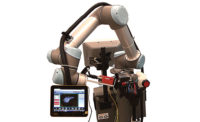Product traceability is essential for every automotive supplier, regardless of its specialty. International supplier Continental Automotive Group, for example, requires traceability of all of its products, including parts for brake systems, power trains, chassis, tires and vehicle electronics.
In 2014, the company expects to reach 35 billion euros in sales, a slight increase from 33.3 billion euros in 2013. It currently employs nearly 178,000 people in 49 countries.
At Continental’s main plant in Frankfurt, Germany, workers assemble a high volume of electronic brake systems. Most system components are transported on trays to workstations.
Each tray has a sticker with a bar code or 2D matrix code. Because the tray travels a fairly long distance during production, it is scanned at regular intervals to ensure part traceability.
For many years, workers manually scanned individual tray bar codes with handheld scanners. However, the bar code edges were often blurry and difficult to scan, slowing production.
So in 2013, Continental worked with Stemmer Imaging to automate this process. Today, In-Sight intelligent vision systems from Cognex Corp. automatically read the codes on a stack of trays (up to 11 high) within a few milliseconds.
“With its five-megapixel resolution, the system locates codes and identifies their edges, then differentiates their type and reads the information into the logistics system,” explains Marc Wilhelm, an engineer for Continental and manager of the plant’s automated-scanning project. “The bottom code serves as the master code by which the entire stack is identified. Thus, at a downstream inspection point it is not necessary to reread all of the individual codes.”
PatMax technology performs geometric pattern matching, enabling the system to immediately identify the bar codes’ edges. Christian Berg, image processing solutions salesman for Stemmer Imaging, says the technology eliminates the need for duplicate scanning.
“It captures the geometry of the code with the help of several boundary curves that are not tied to any pixel grid, and then looks for similar shapes in the image, without making use of specific grayscale values,” says Berg. “As a result, it locates parts reliably and precisely—even with varying angles, sizes and shading.”
The vision system also verifies the number of trays in each stack.
Wilhelm says this extra step eliminates the chance of an uncoded tray passing through a scanning station.
According to Wilhelm, the new system is much faster than manual scanning and has significantly increased production. For these reasons, Continental plans to implement the vision system in other logistics applications at the Frankfurt plant.
For more information on automated vision systems, call 855-426-4639 or visit www.cognex.com.



